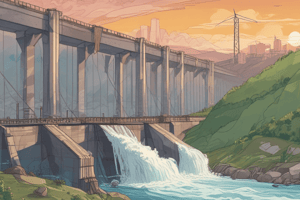Podcast
Questions and Answers
Which of the following is a primary function of a penstock in a hydropower plant?
Which of the following is a primary function of a penstock in a hydropower plant?
- To carry water away from the turbine.
- To channel water from the reservoir to the turbine. (correct)
- To convert rotational energy into electrical energy.
- To convert kinetic energy into rotational energy.
How does pumped storage hydropower contribute to grid stability?
How does pumped storage hydropower contribute to grid stability?
- By directly reducing greenhouse gas emissions during electricity generation.
- By providing a constant and uninterrupted supply of electricity, unaffected by demand fluctuations.
- By increasing the water levels in reservoirs, benefiting downstream irrigation.
- By storing energy during low demand and releasing it during peak demand. (correct)
What is a key difference between impoundment hydropower and diversion (run-of-river) hydropower?
What is a key difference between impoundment hydropower and diversion (run-of-river) hydropower?
- Diversion hydropower is more reliable due to its consistent water source.
- Diversion hydropower relies on a large reservoir, while impoundment does not.
- Impoundment hydropower always has a smaller environmental impact.
- Impoundment hydropower uses a dam to create a reservoir, while diversion diverts a portion of the river's flow. (correct)
Which of the following environmental issues is most directly associated with the construction of dams for hydropower?
Which of the following environmental issues is most directly associated with the construction of dams for hydropower?
What is the primary reason hydropower is considered a renewable energy source?
What is the primary reason hydropower is considered a renewable energy source?
Which factor most significantly determines the amount of electricity a hydropower plant can generate?
Which factor most significantly determines the amount of electricity a hydropower plant can generate?
What is a significant advantage of hydropower beyond electricity generation?
What is a significant advantage of hydropower beyond electricity generation?
Which mitigation strategy is used to address the impact of dams on fish migration?
Which mitigation strategy is used to address the impact of dams on fish migration?
Why might reservoir creation for hydropower lead to increased methane emissions?
Why might reservoir creation for hydropower lead to increased methane emissions?
Which of the following is a strategy for the future of hydropower, balancing energy needs with environmental concerns?
Which of the following is a strategy for the future of hydropower, balancing energy needs with environmental concerns?
Flashcards
Hydropower
Hydropower
Using moving water's energy to generate electricity.
Hydropower Generation
Hydropower Generation
Potential energy of water stored at height converts to kinetic energy as it flows downhill. This drives turbines to produce electricity.
Impoundment Hydropower
Impoundment Hydropower
Most common type; uses a dam to create a large water reservoir.
Diversion (Run-of-River) Hydropower
Diversion (Run-of-River) Hydropower
Signup and view all the flashcards
Pumped Storage Hydropower
Pumped Storage Hydropower
Signup and view all the flashcards
Hydropower as Renewable Energy
Hydropower as Renewable Energy
Signup and view all the flashcards
Environmental Impact of Hydropower
Environmental Impact of Hydropower
Signup and view all the flashcards
Mitigation for Fish Migration
Mitigation for Fish Migration
Signup and view all the flashcards
Modernizing Hydropower
Modernizing Hydropower
Signup and view all the flashcards
Small Hydropower Development
Small Hydropower Development
Signup and view all the flashcards
Study Notes
- Hydropower, also known as hydroelectric power, utilizes the energy of moving water to generate electricity.
- It is considered a renewable energy source because the water cycle is continuously replenishing the water used in hydropower generation.
- Hydropower is one of the oldest and most widely used renewable energy technologies.
Hydropower Generation
- Hydropower plants convert the potential energy of water stored at a height into kinetic energy as it flows downhill, which then drives turbines to produce electricity.
- The amount of electricity generated depends on the volume of water flow and the height difference (head) between the water source and the turbine.
- The basic components of a hydropower plant include a dam (or reservoir), a water intake, a penstock (channel or pipe), a turbine, a generator, and a tailrace.
- The dam creates a reservoir and controls the flow of water.
- The water intake directs water from the reservoir into the penstock.
- The penstock channels the water to the turbine.
- The turbine converts the kinetic energy of the water into rotational energy.
- The generator converts the rotational energy of the turbine into electrical energy.
- The tailrace carries the water away from the turbine back into the river or stream.
Types of Hydropower Plants
- Impoundment Hydropower:
- This is the most common type of hydropower plant.
- It involves a dam that creates a large reservoir of water.
- Water is released from the reservoir to flow through turbines, generating electricity.
- Impoundment hydropower plants can store large amounts of water, providing a reliable source of electricity and also offering flood control and water supply benefits.
- Diversion (Run-of-River) Hydropower:
- This type diverts a portion of a river's flow through a channel or penstock to power a turbine.
- It typically does not require a large reservoir or dam.
- Run-of-river hydropower plants have a smaller environmental impact compared to impoundment hydropower since they do not drastically alter the river's flow.
- However, their electricity generation can vary depending on the river's natural flow rate.
- Pumped Storage Hydropower:
- This type acts like a giant battery, storing energy by pumping water from a lower reservoir to an upper reservoir during times of low electricity demand.
- During peak demand, the stored water is released back down to generate electricity.
- Pumped storage hydropower plants provide grid stability and can help balance the fluctuating output of other renewable energy sources like solar and wind.
Advantages of Hydropower
- Renewable Energy Source: Relies on continuously replenished water cycle.
- Low Greenhouse Gas Emissions: Minimal emissions during operation compared to fossil fuel-based power plants.
- Reliable Power Source: Can provide a stable and dispatchable source of electricity.
- Water Management Benefits: Reservoirs can offer flood control, water supply, and irrigation benefits.
- Long Lifespan: Hydropower plants can operate for many decades with proper maintenance.
Disadvantages of Hydropower
- Environmental Impact: Dam construction can alter river ecosystems, disrupt fish migration, and inundate land.
- High Initial Cost: Building hydropower plants requires significant upfront investment.
- Site Specificity: Suitable locations for hydropower plants are limited by topography and water availability.
- Potential for Displacement: Reservoir creation can displace human populations and wildlife habitats.
- Sedimentation: Dams can trap sediment, reducing downstream sediment supply and affecting river morphology.
Environmental Considerations
- Fish Migration: Dams can block fish migration routes, impacting fish populations. Mitigation measures include fish ladders, fish screens, and bypass channels.
- Water Quality: Reservoirs can alter water temperature, dissolved oxygen levels, and nutrient cycling, potentially affecting aquatic life.
- Habitat Loss: Reservoir creation can inundate terrestrial habitats and alter downstream riparian ecosystems.
- Greenhouse Gas Emissions: While hydropower operation has low emissions, reservoir creation can lead to methane emissions from decomposing organic matter in the flooded area.
- River Flow Alterations: Dams can alter natural river flow patterns, affecting downstream ecosystems and water availability.
Global Hydropower Capacity
- Hydropower is a significant source of electricity worldwide, with many countries relying on it for a substantial portion of their power needs.
- China, Brazil, Canada, the United States, and Russia are among the leading countries in terms of installed hydropower capacity.
- The potential for hydropower development varies by region, with some areas having abundant resources and others facing limitations due to environmental or social concerns.
Future of Hydropower
- Modernization and Upgrading: Improving the efficiency and performance of existing hydropower plants through upgrades and technological advancements.
- Small Hydropower Development: Developing small-scale hydropower projects that have a lower environmental impact and can provide electricity to remote communities.
- Pumped Storage Expansion: Increasing pumped storage capacity to support the integration of variable renewable energy sources like solar and wind.
- Environmental Mitigation: Implementing measures to minimize the environmental impacts of hydropower, such as fish passage facilities and improved reservoir management practices.
- Sustainable Hydropower: Developing hydropower projects in a way that balances energy needs with environmental and social considerations.
Studying That Suits You
Use AI to generate personalized quizzes and flashcards to suit your learning preferences.




